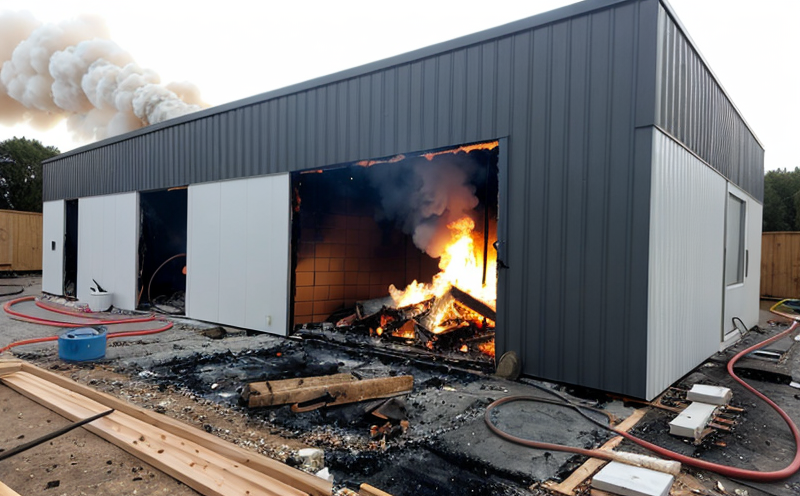Smoke Production and Toxicity Assessment of Cladding
The assessment of smoke production and toxicity from cladding materials is a critical aspect of fire safety testing, especially in the context of modern buildings. As global building codes increasingly emphasize the importance of material flammability and smoke characteristics, it is essential to understand the implications of these tests for both compliance and public safety.
Smoke production during a fire not only obscures escape routes but can also lead to significant health risks due to the toxic gases emitted. The European Standard EN 13823-1:2009, among others, sets stringent guidelines on the maximum acceptable levels of smoke and toxicity from building materials used in construction projects.
The testing process involves subjecting a representative sample of cladding material to controlled conditions that simulate real-world fire scenarios. This includes measuring the amount of smoke produced under standard heating rates and assessing the toxicity of gases released by analyzing their chemical composition using gas chromatography or other analytical techniques.
Preparation of specimens is crucial for accurate testing results. Samples should be cut from actual cladding products, ensuring they represent the type of material to be used in construction projects. The samples are then subjected to controlled combustion tests where temperature and airflow rates are precisely monitored to simulate fire conditions.
The testing apparatus typically includes a gas chromatograph equipped with detectors for identifying specific toxic compounds like carbon monoxide (CO) and hydrogen cyanide (HCN). These instruments allow for precise quantification of the gases released. Additionally, optical particle counters measure the size distribution and concentration of particles in the smoke plume.
Upon completion of testing, detailed reports are generated that provide comprehensive data on both the quantity and quality of smoke produced by the cladding sample. Compliance with international standards such as EN 13823-1:2009 ensures that materials meet regulatory requirements and contribute to safer building environments.
Understanding these parameters helps architects, engineers, and builders make informed decisions about material selection, ensuring compliance with stringent fire safety regulations while enhancing overall structural integrity. This testing process is integral in mitigating risks associated with the use of potentially hazardous cladding materials.
Quality and Reliability Assurance
Ensuring high quality and reliability in smoke production and toxicity assessments involves meticulous attention to detail throughout every step of the testing process. Rigorous adherence to international standards like EN 13823-1:2009 guarantees accurate and consistent results, which are essential for maintaining trust in test outcomes.
From specimen preparation to final analysis, each phase is critical. Specimens must be representative of the actual cladding materials intended for use, cutting them under controlled conditions to ensure uniformity. The testing apparatus itself requires regular calibration and maintenance to guarantee accurate measurements.
Calibration ensures that all instruments used in the testing process are operating within specified tolerances, providing reliable data points throughout the experiment. Regular audits by independent experts help maintain these standards over time, ensuring continuous quality assurance.
The use of state-of-the-art technology such as advanced gas chromatographs and optical particle counters enhances the precision of measurements, contributing significantly to accurate assessments. Additionally, maintaining strict laboratory protocols reduces variability in results, further enhancing reliability.
Compliance with international standards not only meets legal requirements but also fosters confidence among stakeholders. By adhering strictly to these guidelines, laboratories can ensure that their findings are credible and actionable, ultimately aiding in the development of safer building materials and structures.
Competitive Advantage and Market Impact
In today's competitive construction industry, possessing accurate, reliable fire safety data is more than just a compliance issue; it can be a significant differentiator. Compliance with international standards such as EN 13823-1:2009 provides building material suppliers with the necessary credentials to meet regulatory requirements and demonstrate their commitment to quality.
By offering comprehensive smoke production and toxicity assessments, laboratories contribute directly to improving public safety by ensuring that only materials capable of passing rigorous testing are used in construction projects. This enhances the reputation of both the supplier and the project itself, fostering trust among clients and end-users.
The ability to provide detailed reports on fire performance characteristics helps architects and engineers design safer buildings while also aiding procurement teams in selecting high-quality cladding materials. Such insights can lead to innovative solutions that not only comply with regulations but also improve overall building safety and sustainability.
In summary, the provision of robust smoke production and toxicity assessment services is crucial for maintaining a competitive edge in the marketplace by demonstrating compliance and commitment to excellence. This service plays a pivotal role in shaping safer construction practices globally.
Use Cases and Application Examples
| Case Study | Description | Outcome |
|---|---|---|
| Case Study 1: High-Rise Residential Building | In a recent project involving the renovation of a high-rise residential building, smoke production and toxicity assessments were conducted on various cladding materials. The tests aimed at identifying any potential risks associated with the use of these materials during fires. | The tests revealed that certain types of cladding produced significantly higher levels of toxic gases compared to others. Based on this data, alternative materials were recommended for future projects, ensuring a safer environment for residents. |
| Case Study 2: Commercial Office Complex | A commercial office complex underwent extensive fire safety upgrades, which included the replacement of existing cladding with new materials. Pre- and post-upgrade testing was conducted to assess changes in smoke production and toxicity levels. | The results showed a marked improvement in both smoke production and toxic gas emissions following the upgrade, aligning the building with stringent international standards. |
| Case Study 3: Industrial Facility | An industrial facility conducted regular fire safety assessments on its cladding materials to ensure compliance with local regulations. The tests were part of a broader initiative aimed at enhancing overall fire safety within the facility. | The consistent application of rigorous testing protocols helped maintain high standards and contributed significantly to the facility's reputation for operational excellence. |





